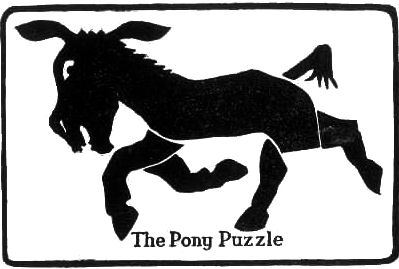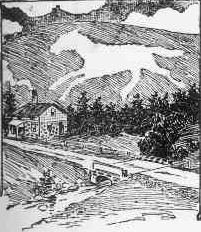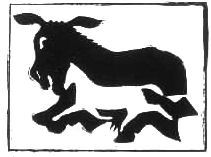



SPEAKING ABOUT MY my first, and as a matter of fact most successful puzzle, I wish to say that it was originated nearly half a century ago under the following circumstances:
I was returning from Europe many years ago in company with Andrew G. Curtin, the famous war Governor of Pennsylvania, who was returning from his post in Russia as a prospective Presidential candidate. We were walking the deck of the steamer, discoursing on the curious White Horse monument on Uppington Hill Berkshire England If you know nothing about that weird relic of the early Saxons the accompanying sketch will afford an excellent idea of its appearance.

It represents the figure of a colossal white horse, several hundred feet long, engraved on the side of the mountain, about a thousand feet above the level of the sea, so that it can be clearly distinguished at a distance of some fifteen miles. It is more than a thousand years old. And is supposed to have been carved there by the soldiers of Ethelred and Alfred after their victory over the Danes, as a white horse was the emblem of the Saxons.
It looks like a patch of snow on the side of the mountain, but it is in reality produced by the green turf being removed so as to show the white chalk beneath in the form of a horse.
I am thus prolix in the description of this piece of ancient history, because it is but fair that Ethelred and Alfred should receive their share of the anathemas generally hurled at the inventor of the Pony Puzzle by those who see the answer.
After the white horse had been thoroughly discussed, the governor banteringly exclaimed:
“Now, Loyd, there would be a capital subject for a puzzle.” Many a good puzzle idea has come from just such a tip; so, with such a capital theme, I should have been supremely stupid if I had not evolved something in response to the challenge. So, with my scissors and a piece of silhouette paper, I speedily improvised the accompanying figure of a horse, which we christened “The Pony Puzzle.”
It would be a simple matter to improve the parts and general form of the old horse, and I really did modify it in the version which I afterward published, but somehow I love the old nag best as first devised, with all its faults, so I now present it as it actually occurred to me.
The world has been moving rapidly during the last decade, and puzzlers are much sharper than they used to be. In those days very few, probably not one out of a thousand, actually mastered the puzzle, so it will be a capital test of the acumen of the past compared with that of the present generation, to see how many of our clever wits of today can solve it.
Trace an exact copy of the figure, as shown, and cut out the six pieces very carefully, and then try to arrange them together so as to make the best possible figure of a horse. That is all there is to it, but the entire world laughed for a year over the many grotesque representations of a horse which can be made with those six pieces.
I sold over one thousand millions of “The Pony Puzzle,” which reminds me to say that, whereas I have brought out many puzzles, and patented numerous inventions of more or less importance, and devoted much time and money, to my sorrow, upon the “big things.” More money is made from little things like “The Pony Puzzle,” which do not require a five-dollar bill to promote and to place on the market.
The garrulity of old age has led me into saying so much about the pedigree of this old nag that I will have to carry over to another time some remarks of practical utility which I desire to offer to such as are ambitious to present their puzzles or other inventions to the public.
In presenting the answer to the Pony Puzzle, Mr. Loyd takes occasion to point out the fact of the black pieces of paper being nothing but a delusion and a snare. The pieces are to be placed so as to make the representation of a little white horse in the center as shown.

It was this trick of the white horse of Uppington which popularized the slang expression: “Oh, but that is a horse of another color!”
2.
Why are washerwomen great travelers?
Because they are continually crossing the line and running from pole to pole.
What is the largest room in the world ?
The room for improvement.
Why is a street cat like the heart of a coquette ?
Because there is always room for one more to be taken in.
When may a man be said to breakfast before he gets up?
When he takes a roll in bed.
Why are teeth like verbs?
Because they are regular, irregular, and defective.
What is it that a gentleman has not, never can have, and yet can give to a lady?
A husband.
Why is a man just imprisoned like a boat full of water?
Because he requires bailing out.
When does a ship tell a falsehood?
When she lies at the wharf.
What is the difference between a mother and a barber?
The latter has razors to shave and the former has shavers to raise.
Why are fowls the most economical things a farmer can keep?
Because for every grain they give a peck.
[Page 17]